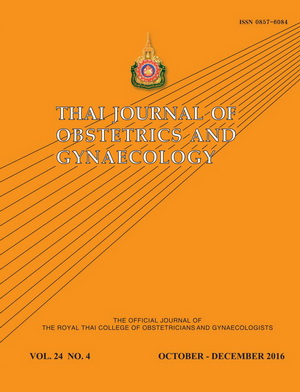Prevalence and Risk Factors of Fetal Laceration Injury associated with Cesarean Delivery
Main Article Content
Abstract
Objective: To determine the prevalence and risk factors of fetal laceration injury during cesarean delivery.
Materials and methods: Computer-based delivery records of Rajavithi Hospital were retrospective reviewed between January 2009 and December 2013. All data including maternal characteristics, neonatal outcomes, operative records and complications of cesarean delivery were collected. Prevalence of fetal laceration injury during cesarean delivery was calculated. Comparison was made between those with and without fetal laceration injury.
Results: During the study period, cesarean deliveris were performed in 10,540 of total 29,532 deliveries (35.7%). Five hundred and fifty cesarean deliveries were met the exclusion criteria. The remaining 9,970 deliveries were analyzed. Thirty-two newborns (0.3%) had observed laceration injury from cesarean delivery. Common sites of laceration injuries were on faces and most of injuries were mild lacerations. Membranes rupture before undergoing cesarean delivery (OR=2.04, 95%CI=1.02 – 4.08) and young maternal age group (OR=3.93, 95%CI=1.58-9.78) are significant risk factors for fetal laceration injury associated with cesarean delivery. Experience of operator, urgency of cesarean delivery and neonatal outcomes show no related association with the injury.
Conclusion: Fetal laceration injury associated with cesarean delivery is uncommon. Rupture of membranes before undergoing cesarean delivery and young maternal age group are major risk factors for the injury. Women with risk factors should be carefully operated during cesarean delivery.


